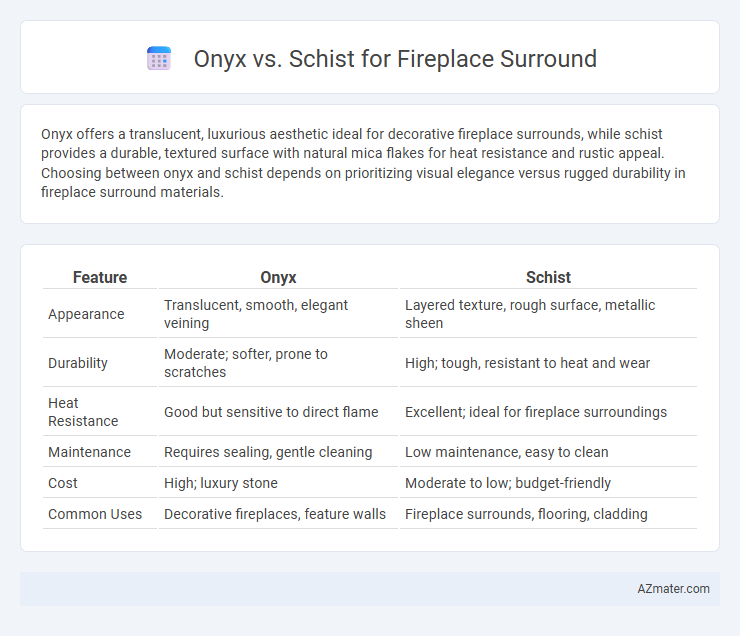Onyx offers a translucent, luxurious aesthetic ideal for decorative fireplace surrounds, while schist provides a durable, textured surface with natural mica flakes for heat resistance and rustic appeal. Choosing between onyx and schist depends on prioritizing visual elegance versus rugged durability in fireplace surround materials.
Table of Comparison
| Feature | Onyx | Schist |
|---|---|---|
| Appearance | Translucent, smooth, elegant veining | Layered texture, rough surface, metallic sheen |
| Durability | Moderate; softer, prone to scratches | High; tough, resistant to heat and wear |
| Heat Resistance | Good but sensitive to direct flame | Excellent; ideal for fireplace surroundings |
| Maintenance | Requires sealing, gentle cleaning | Low maintenance, easy to clean |
| Cost | High; luxury stone | Moderate to low; budget-friendly |
| Common Uses | Decorative fireplaces, feature walls | Fireplace surrounds, flooring, cladding |
Introduction to Onyx and Schist as Fireplace Surrounds
Onyx and schist are popular materials for fireplace surrounds, each offering unique aesthetic and functional benefits. Onyx, a translucent natural stone, provides a luxurious, glowing effect when backlit, making it an ideal choice for adding warmth and elegance to living spaces. Schist, a durable metamorphic rock with a layered, textured appearance, offers a rustic, earthy charm and excellent heat resistance, ensuring both style and practicality for fireplace installations.
Visual Appeal: Comparing Onyx and Schist Aesthetics
Onyx offers a translucent, luminous quality with rich, swirling patterns that create a striking and elegant fireplace surround, making it a standout centerpiece in any room. Schist features a textured, layered appearance with natural metallic flecks, providing a rustic yet sophisticated aesthetic that complements both modern and traditional decor. The choice between Onyx and Schist depends on whether you prefer a glossy, luxurious look or a more rugged, earthy visual appeal.
Durability and Longevity of Onyx vs Schist
Onyx offers a unique, translucent appearance but is softer and more prone to scratching and etching compared to schist, which is a highly durable metamorphic rock known for its resistance to heat and wear. Schist's natural foliation and toughness make it an ideal choice for fireplace surrounds requiring long-term durability, while onyx requires more careful maintenance to sustain its aesthetic over time. For longevity, schist outperforms onyx by resisting chipping and discoloration, ensuring the fireplace surround remains structurally sound and visually appealing for decades.
Heat Resistance and Fire Safety Considerations
Onyx and schist differ significantly in heat resistance and fire safety for fireplace surrounds. Onyx, a softer, more porous natural stone, is less heat resistant and can crack or discolor when exposed to high temperatures, making it less ideal for fireplace surrounds. Schist, composed of layered metamorphic minerals like mica, offers superior heat resistance and durability, ensuring enhanced fire safety and longevity in fireplace applications.
Maintenance Needs: Onyx vs Schist
Onyx fireplace surrounds require regular sealing and gentle cleaning with pH-neutral products due to their porous and softer nature, making them more susceptible to scratches and etching. Schist, being a durable metamorphic rock with natural clefts and a denser structure, demands less frequent sealing and is more resistant to heat, stains, and daily wear. Choosing schist reduces maintenance efforts, while onyx offers a luxurious look that requires diligent care to preserve its luster.
Installation Process: What to Expect
Onyx requires careful handling due to its delicate nature, demanding skilled labor and specialized tools during installation to prevent cracking or damage, often resulting in higher labor costs and longer installation times. Schist, being more durable and easier to cut, allows for a smoother and quicker installation process with more flexibility in cutting and fitting around the fireplace surround. Expect Onyx installations to involve precise measurements and sealing to protect its translucency, while Schist provides a robust, low-maintenance finish with simpler installation requirements.
Cost Comparison: Onyx vs Schist for Fireplaces
Onyx fireplace surrounds typically cost between $60 to $100 per square foot due to their translucent and luxurious appearance, while schist ranges from $30 to $70 per square foot, offering a more affordable yet durable option. Installation costs for onyx may be higher because of its delicate nature requiring specialized handling, whereas schist's robustness allows for easier and less expensive installation. Budget-conscious homeowners often choose schist for cost savings without sacrificing natural stone aesthetics in fireplace surrounds.
Design Versatility and Customization Options
Onyx provides exceptional design versatility for fireplace surrounds due to its translucent properties, allowing for creative backlighting effects that enhance ambiance and highlight natural veining patterns. Schist offers customization through its layered texture and earthy color variations, creating a rustic, tactile surface ideal for unique, durable fireplace designs. Both materials support tailored installations, but onyx excels in customization with its ability to be carved and illuminated for dramatic visual impact.
Environmental Impact and Sourcing
Onyx, a translucent and softer stone, often requires more energy-intensive mining methods that can result in higher environmental impact compared to schist, which is more abundant and typically quarried with less ecological disturbance. Schist's natural abundance reduces the carbon footprint associated with extraction and transportation, making it a more sustainable choice for fireplace surrounds. Choosing locally sourced schist can further minimize environmental impact by reducing transportation emissions and supporting responsible quarrying practices.
Choosing the Right Stone for Your Fireplace Surround
Onyx offers a luxurious, translucent appearance with rich color variations ideal for creating a dramatic fireplace surround, while schist provides a durable, textured surface with natural shimmer that withstands heat and everyday wear. Selecting the right stone depends on factors like aesthetic preference, heat resistance, maintenance requirements, and budget; onyx requires more care due to its softness and susceptibility to scratches, whereas schist's toughness ensures long-lasting performance. Considering the fireplace's design style and functional needs will help determine whether onyx's elegance or schist's rugged beauty best complements your living space.

Infographic: Onyx vs Schist for Fireplace Surround
 azmater.com
azmater.com